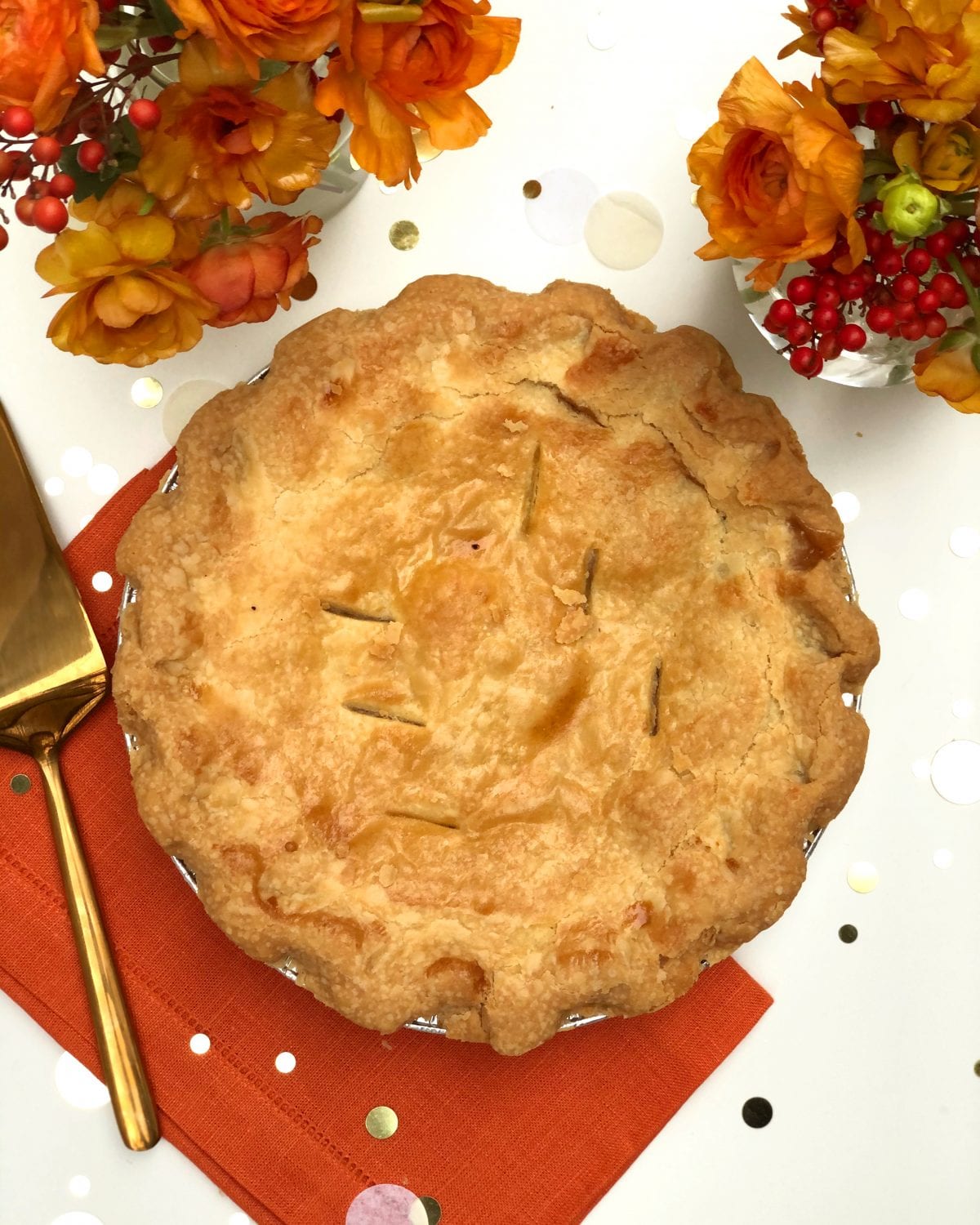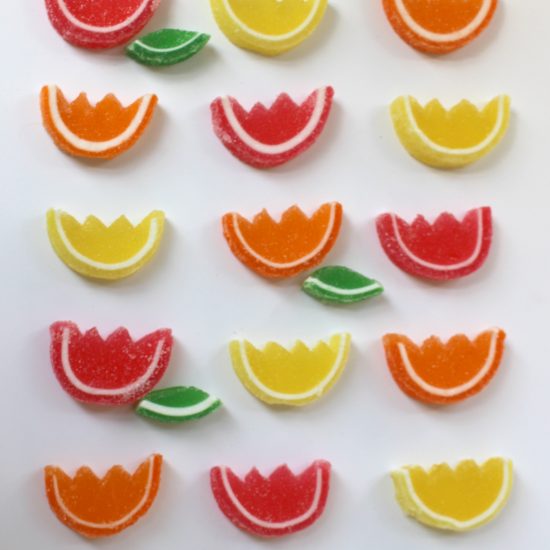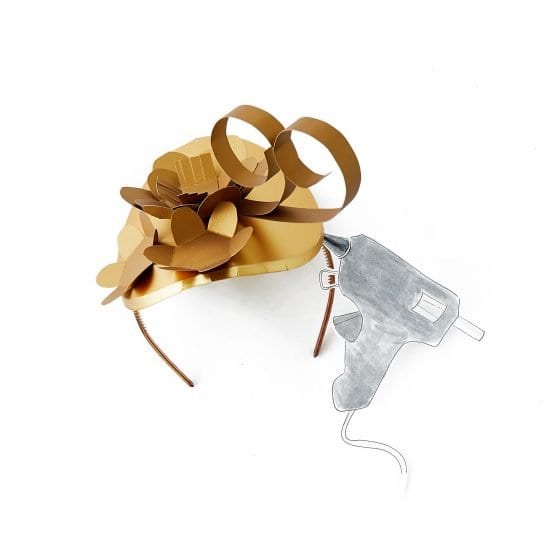
Nothing beats a pie that looks great, tastes delicious, and is baked with a whole lot of love. We asked Petra Paredez, owner of Petee’s Pies to share one of her recipes. She gave us this how-to for her beloved Butter Crust Apple Pie, which is a winner any way you slice it.
Butter Crust Apple Pie
Makes one 9 inch pie.
This is my classic apple pie. Baked in a butter crust and served warm, it will win over even those who think apple pie is boring, basic, or dull. The flavor is apple-y above all else—not overly spiced or sweetened. It has just the right amount of salt to round out the flavor and enhance the warmth of the spices. As long as you use nice, firm apples, the texture will have a little bite and will be neither dry nor runny. Consider using an heirloom variety such as Arkansas Black, Ashmead’s Kernel, Bramley’s Seedling, or Newtown Pippin.
Butter pastry dough:
- 1 tablespoon sugar
- 1 1/4 teaspoons salt
- 1/4 cup boiling water
- 1 1/2 loosely filled cups (170 g) pastry flour, from the freezer
- 2/3 loosely filled cups (85 g) all-purpose flour, from the freezer
- 1/2 pound (225 g) cold unsalted butter, cut into ½” cubes
- Extra flour for rollingApple filling:
- 1 1/2 pounds peeled sliced apples
- 2 teaspoons lemon juice
- 2 tablespoons light brown sugar
- 1/3 cup sugar
- 1 tablespoon plus 2 teaspoons tapioca starch
- Scant 1/2 teaspoon cinnamon
- 1/8 teaspoon nutmeg
- Scant 1/2 teaspoon salt
Egg wash:
- 1 large egg
- 2 tablespoons sugar
Make the pastry dough:
–Stir salt, sugar, and water together in a small bowl until salt and sugar are fully dissolved. Place the bowl in the freezer—the dough liquid needs to be ice cold before it is added to the dough.
– Put the pastry flour and all-purpose flour in a large bowl and dump the butter cubes into the flour. Toss to coat the butter in the flour. Working quickly, use your thumbs and index fingers to squeeze each butter cube into a thin sheet, between 1/8 and ¼-inch thick. Shake the contents of the bowl to make sure the sheets are well-coated in flour.
– Sprinkle the ice-cold sugar-salt solution over the fat and flour. Use your fingers to lightly toss the contents of the bowl around once more to disperse the liquid.
– Then, squeeze the shaggy mess in your fists, repeatedly and quickly, until the chunks get bigger and more cohesive. At first it will be crumbly and seem as if it won’t come together, but with continued compression, you can begin to make two mounds of dough. Flatten your mounds into 1-inch thick discs.
Make the apple filling:
In a large bowl, combine the sliced apples and lemon juice, then add the brown sugar. In a small bowl, mix the sugar, tapioca starch, cinnamon, nutmeg, and salt, making sure that the starch is dispersed evenly. Pour the sugar-spice mixture over the apples and toss to combine.
Assemble the pie:
Preheat your oven to 400°F.
–Prepare a clean, dry, non-porous surface by sprinkling it with the flour appropriate for your choice of dough. Place a disc of dough on top of the flour and sprinkle it with a little more flour. Place your rolling pin in the center of the dough and with firm, even pressure, but not enough force to squish the dough, roll away from you. As you approach the edge of the dough, use a little less pressure so that it doesn’t become too thin on the edges.
–Rotate the dough about 45 degrees. Place the rolling pin at the center of the disc, and roll away from yourself once again. Continue to rotate and roll, adding more flour as needed to prevent sticking, until you’ve rolled the dough to approximately 1/8 inch thickness. If the dough starts to split on the edge, you can gently press it back together before continuing to roll it out. The finished sheet of dough should be roughly 11-inches in diameter.
–Transfer the sheet of dough into a pie pan, centering it so that you have at least 1 inch of extra dough all the way around the edge of the pan. While transferring, support the dough with your fingers spread out, in order to distribute the weight and prevent breakage. Once the sheet of dough is in the pan, ease it into the corner where the base of the pan meets the sides. In order to do this without stretching or breaking the dough, lift the edge of the dough with one hand to allow it to fall into place, while gently pressing it into the corner. Trim the bottom crust by running a knife all the way around the edge.
–Transfer the filling into the bottom crust, making sure to scrape the bowl with a rubber spatula to get all the juicy spiced sugar. Then, use a pastry brush to gently brush water around the rim of the bottom crust.
–Roll a top crust in the same manner as the bottom and place it on top. Trim the top crust so that there is about 1/2 inch of extra dough all the way around the edge. Lift the edge of the bottom crust up and tuck the extra dough underneath it.
–Now you’re ready to crimp the crust! Position the thumb and forefinger of your non-dominant hand so that there’s about ½ inch between them, and push them gently into the edge of the crust, right over the rim of the pie dish. Using the forefinger of your dominant hand, push the dough from the inside of the edge into the space between your thumb and forefinger. With your non-dominant hand, move your thumb into the spot that your index finger just occupied and repeat the same motion. Continue all the way around the edge of the pie.
–Make the eggwash by beating together 2 tablespoons of sugar and one large egg in a small bowl. Brush the surface of the pie with egg wash, avoiding the crimped edges and taking care not to allow the egg wash to pool up in any recessed areas. Place the pie on a baking sheet to collect any juices that bubble over.
Bake for 20 minutes at 400°F, then reduce the heat and continue to bake for 40 more minutes, or until the filling has been bubbling for at least 10 minutes.
Allow to cool for at least 30 minutes before serving to make slicing and serving easier. The pie will keep for up to 3 days at room temperature.
photo credits



